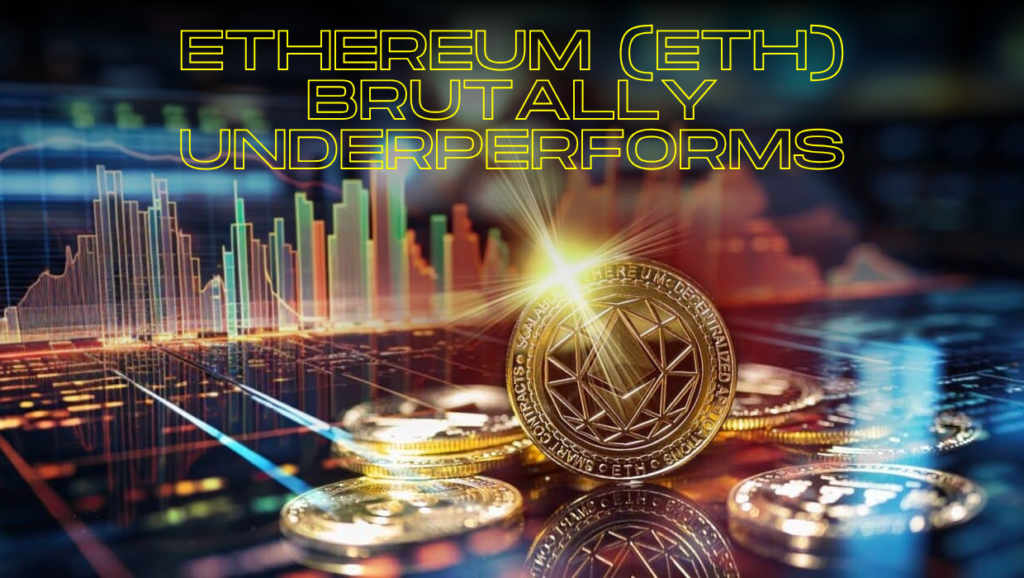
Disclaimer: Our writers’ opinions are their own and do not always reflect those of U.Today. U.Today’s market and financial data are provided solely for informative reasons. Any monetary losses sustained when trading cryptocurrencies are not U.Today’s responsibility. Before making any investing decisions, do your own homework by speaking with financial professionals. Although we think that the information is correct as of the publication date, some of the offers mentioned might not be accessible anymore.
Ethereum has struggled to stay ahead of its top competitors, including XRP and Solana, despite being hailed as the second most important cryptocurrency. While Ethereum’s market value decreased by 4.7 percent over the past month, XRP and Solana experienced rises of 36.9% and 32.2%, respectively. This stark discrepancy has angered many ETH traders, who are starting to question the asset’s current trajectory.
As more attention is focused on assets that are performing well, the market’s image of Ethereum has been steadily shifting. For example, XRP and Solana have drawn notice because of their remarkable increases in market value, whilst Ethereum has trailed behind. Not all people are disregarding this subpar performance, and others are questioning whether this trend indicates more significant issues inside the Ethereum ecosystem.

Ethereum’s recent price issues could have been influenced by investor mood. The leadership decisions and asset consolidation have garnered fresh interest. Market sell-offs have often resulted from regular ETH sales by well-known individuals and organizations, raising concerns about investors’ confidence in Ethereum’s long-term prospects.
Although such actions are typically justified as necessary for operational funds, they have had a lasting impact on trading mood. The centralization of Ethereum’s network has also drawn criticism. A substantial portion of staked Ethereum is controlled by a few entities, including significant exchanges and staking platforms. This concentration has sparked questions about Ethereum’s ability to maintain true decentralization, especially in light of instances where the network appeared to follow external regulations such transaction blocking related to controversial cases.
Ethereum’s unrivaled developer application and decentralized finance ecosystem allow it to maintain its market dominance despite these challenges. However, current market dynamics show that innovation and sentiment play a critical role in cryptocurrency acceptance. If Ethereum want to recapture its momentum as XRP and Solana continue to succeed, it must address these growing concerns and adapt to a more competitive market. Ethereum investors are still on edge and keeping a careful eye on the market’s movement.
FAQs
Ethereum has seen a 4.7% decline in market value over the past month, while XRP and Solana have experienced significant gains of 36.9% and 32.2%, respectively. Factors contributing to Ethereum’s underperformance include investor sentiment, centralized staking concerns, and regular sell-offs by prominent entities. These dynamics have led to a shift in market perception of Ethereum’s trajectory.
Critics point to the fact that a large portion of staked Ethereum is controlled by a few major entities, including exchanges and staking platforms. This concentration raises questions about Ethereum’s ability to remain truly decentralized. Instances such as network responses to external regulations (e.g., transaction blocking) have further fueled these concerns.
XRP and Solana have gained attention due to their significant price increases and strong market sentiment. Their growth has been fueled by investor confidence, technological advancements, and strategic positioning in the competitive cryptocurrency landscape, allowing them to outpace Ethereum in recent months.
Despite its current challenges, Ethereum remains a leading cryptocurrency due to its robust developer ecosystem, dominance in decentralized finance (DeFi), and established use cases. However, to maintain its position, Ethereum must address market concerns and adapt to the growing competition from assets like XRP and Solana.
To recapture market momentum, Ethereum needs to address issues related to centralization, improve investor confidence, and foster innovation in its ecosystem. Transparent communication, strategic improvements to its network, and competitive positioning against rising cryptocurrencies are crucial for Ethereum’s future success.




 Bitcoin
Bitcoin  Ethereum
Ethereum  Tether
Tether  XRP
XRP  Solana
Solana  USDC
USDC  TRON
TRON  Dogecoin
Dogecoin  Lido Staked Ether
Lido Staked Ether  Cardano
Cardano  Avalanche
Avalanche  Toncoin
Toncoin  Shiba Inu
Shiba Inu  Pepe
Pepe